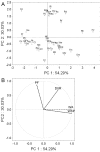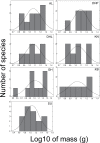The relative influence of competition and prey defenses on the phenotypic structure of insectivorous bat ensembles in southern Africa
- PMID: 19005563
- PMCID: PMC2579324
- DOI: 10.1371/journal.pone.0003715
The relative influence of competition and prey defenses on the phenotypic structure of insectivorous bat ensembles in southern Africa
Abstract
Deterministic filters such as competition and prey defences should have a strong influence on the community structure of animals such as insectivorous bats that have life histories characterized by low fecundity, low predation risk, long life expectancy, and stable populations. We investigated the relative influence of these two deterministic filters on the phenotypic structure of insectivorous bat ensembles in southern Africa. We used null models to simulate the random phenotypic patterns expected in the absence of competition or prey defences and analysed the deviations of the observed phenotypic pattern from these expected random patterns. The phenotypic structure at local scales exhibited non-random patterns consistent with both competition and prey defense hypotheses. There was evidence that competition influenced body size distribution across ensembles. Competition also influenced wing and echolocation patterns in ensembles and in functional foraging groups with high species richness or abundance. At the same time, prey defense filters influenced echolocation patterns in two species-poor ensembles. Non-random patterns remained evident even after we removed the influence of body size from wing morphology and echolocation parameters taking phylogeny into account. However, abiotic filters such as geographic distribution ranges of small and large-bodied species, extinction risk, and the physics of flight and sound probably also interacted with biotic filters at local and/or regional scales to influence the community structure of sympatric bats in southern Africa. Future studies should investigate alternative parameters that define bat community structure such as diet and abundance to better determine the influence of competition and prey defences on the structure of insectivorous bat ensembles in southern Africa.
Conflict of interest statement
Figures




Similar articles
-
The relative influence of competition and prey defences on the trophic structure of animalivorous bat ensembles.Oecologia. 2011 Jun;166(2):493-506. doi: 10.1007/s00442-010-1854-3. Epub 2010 Dec 3. Oecologia. 2011. PMID: 21128085
-
Support for the allotonic frequency hypothesis in an insectivorous bat community.Oecologia. 2003 Jan;134(1):154-62. doi: 10.1007/s00442-002-1107-1. Epub 2002 Nov 9. Oecologia. 2003. PMID: 12647192
-
Bat sonar and wing morphology predict species vertical niche.J Acoust Soc Am. 2019 May;145(5):3242. doi: 10.1121/1.5102166. J Acoust Soc Am. 2019. PMID: 31153342
-
Evolutionary escalation: the bat-moth arms race.J Exp Biol. 2016 Jun 1;219(Pt 11):1589-602. doi: 10.1242/jeb.086686. J Exp Biol. 2016. PMID: 27252453 Review.
-
Adaptations for Substrate Gleaning in Bats: The Pallid Bat as a Case Study.Brain Behav Evol. 2018;91(2):97-108. doi: 10.1159/000488873. Epub 2018 Jun 6. Brain Behav Evol. 2018. PMID: 29874652 Review.
Cited by
-
Correlated genetic and ecological diversification in a widespread southern African horseshoe bat.PLoS One. 2012;7(2):e31946. doi: 10.1371/journal.pone.0031946. Epub 2012 Feb 27. PLoS One. 2012. PMID: 22384108 Free PMC article.
-
Bat predation by spiders.PLoS One. 2013;8(3):e58120. doi: 10.1371/journal.pone.0058120. Epub 2013 Mar 13. PLoS One. 2013. PMID: 23516436 Free PMC article.
-
Animal taxa contrast in their scale-dependent responses to land use change in rural Africa.PLoS One. 2018 May 8;13(5):e0194336. doi: 10.1371/journal.pone.0194336. eCollection 2018. PLoS One. 2018. PMID: 29738559 Free PMC article.
-
A synthesis of ecological and evolutionary determinants of bat diversity across spatial scales.BMC Ecol. 2018 Jun 11;18(1):18. doi: 10.1186/s12898-018-0174-z. BMC Ecol. 2018. PMID: 29890975 Free PMC article. Review.
-
It's not all about the Soprano: Rhinolophid bats use multiple acoustic components in echolocation pulses to discriminate between conspecifics and heterospecifics.PLoS One. 2018 Jul 18;13(7):e0199703. doi: 10.1371/journal.pone.0199703. eCollection 2018. PLoS One. 2018. PMID: 30020963 Free PMC article.
References
-
- Roughgarden J. Competition and theory in community ecology. American Naturalist. 1983;122:583–601.
-
- Strong DR, Simberloff D, Abele LG, Thistle AB. Ecological Communities: Conceptual Issues and the Evidence. Princeton: Princeton University Press; 1984.
-
- Brown JH. Macroecology. Chicago: University of Chicago Press; 1995.
-
- Maurer BA. Untangling Ecological Diversity. Chicago: University of Chicago Press; 1999.
-
- Lawton JH. In: Community Ecology in a Changing World. Kinne O, editor. Oldendorf/Luhe: Ecology Institude; 2000. p. 227.
Publication types
MeSH terms
LinkOut - more resources
Full Text Sources

